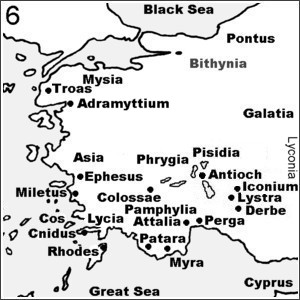
Introduction to Galatians
—Background to Paul’s letter
In this lesson we look at some of the circumstances behind Paul’s letter to the Galatians.
1 An old but profitable letter
Paul’s letter to Galatians is an ancient letter, written mid first century AD, which makes it almost 2000 years old. The original letter no longer exists, but many copies of it over 1500 years old still survive in museums.
Although the letter is very old, we still need its teaching today in this 21st century. Paul claims that his teaching —including this letter— came from God. "I neither received it from man, nor was I taught it, but it came to me by revelation of Jesus Christ" (Galatians 1:12).
Because Galatians is God-breathed scripture, it is profitable for our souls, even though it is so very old. "All scripture is God-breathed and is profitable... that the man of God may be complete..." (2Timothy 3:16)).
2 Where is Galatia?
Nobody knows exactly where the churches of Galatia were located, but the general area (called Turkey today) is above Cyprus north of the Great Sea (the Mediterranean).

3 The Jews in Galatia
Peter also wrote to the Galatians among others. He mentions the Galatians among "exiles of the dispersion (diaspora)" (1Peter 1:1). James also wrote to "the twelve tribes which are scattered abroad" (James 1:1).
This refers to Jews whose homeland was Judea, its capital Jerusalem. However, social, political, economic, and religious pressures caused many Jews to migrate to places like Galatia, where they were still able to keep in touch with "home".
The Jews established synagogues around the world (eg Acts 13:4-5,14). Galatia was no exception. Ruins of synagogues can still be found today in what was once Galatia. Inside these synagogues Paul would teach the Jews, and make converts of some to Jesus Christ.
4 False doctrine in Galatia
You would think Paul would have an easier time with Jewish Christians than with Gentile converts of pagan background. It turned out, however, that Jewish converts were spreading a false doctrine that Christians must keep Jewish laws and customs to be saved (Acts 15:1).
This doctrine arose in Judea, spread up to Syrian Antioch, and then on to Galatia. Paul actively disputed and debated with the false teachers.
So much of what Paul says in the letter is an argument stating Paul’s position on the issue of whether Christians have to keep the Jewish law of Moses. It was no academic question. It was a matter of salvation.
- The false teachers made it so. "Certain ones who came down from Judea (to Syrian Antioch) were teaching the brothers, saying, 'If you are not circumcized according to Moses’s custom, you cannot be saved'". (Acts 15:1).
- Paul made it so. "You have been severed from Christ, you who seek to be justified by the law —you have fallen from grace" (Galatians 5:4).
Paul was referring to this doctrine —although the general application, to any and all false teaching, is not lost on us-- when he said, "If anybody preaches to you a doctrine other than that which we have preached, let him be accursed" (Galatians 1:8-9).